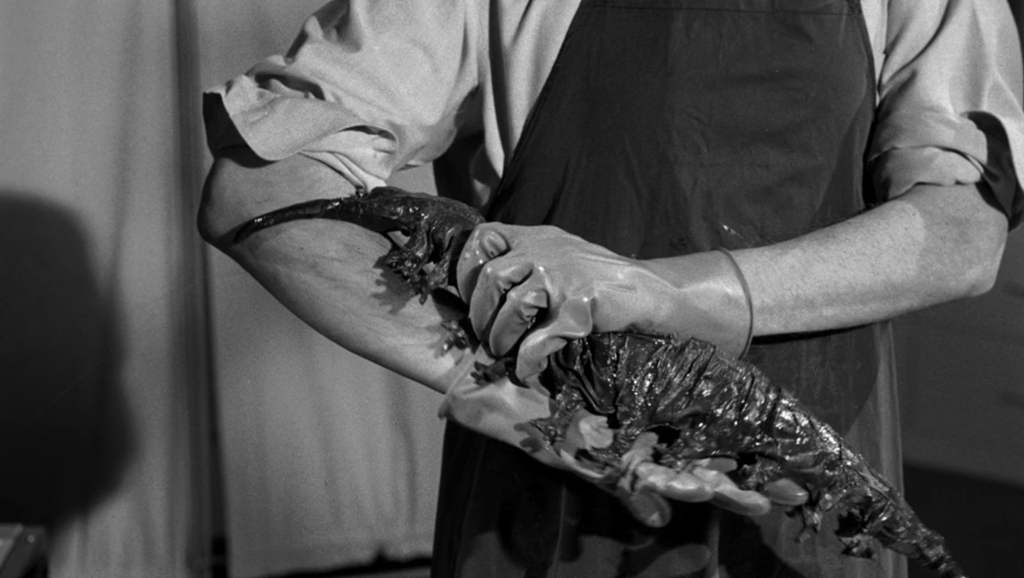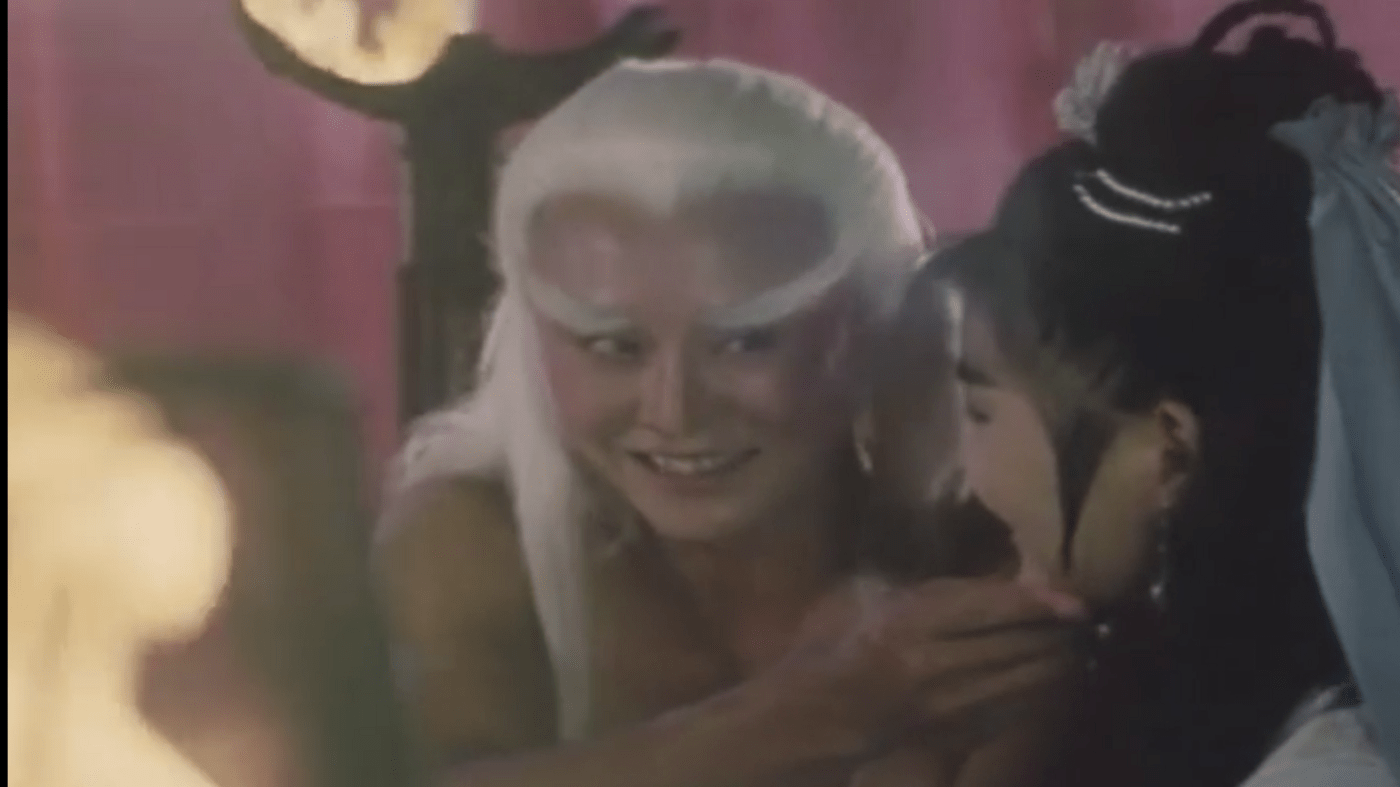
William Castle’s 1959 film The Tingler is legendary. Not for the movie itself, but for what Castle did to the audience. I had heard before about his putting little electric buzzers in the theater seats and zapping the audience at the climactic scene, but it was actually a bit more involved than that, and really pretty clever. The film itself sets up a strangely fluid exchange between the film on the screen and the reality of the audience’s experience.
Before we discuss Castle’s theater shenanigans, we need to provide a little context. The Tingler is ostensibly a science fiction horror movie. It’s a cheap genre film for the teenage crowd. Science fiction is a generous label for something that has a whole lot more fiction in it than science. Dr. Warren Chapin, played by Vincent Price, spends more than half the film explaining his idea of human anatomy and neuroscience to anyone who will listen. The descriptions of how our bodies function is so divorced from reality, they are hard to follow. Sometimes movies require that you suspend a little belief, but what do you do when Vinnie uses a term like “micro-milligrams?” I guess in his world milligrams come in different sizes, or maybe a microgram and a milligram got together, threw on some Barry White, and had a baby?
The Tingler is a weird mix of genres. You have your science fiction, and your horror, but there is a hefty dose of melodrama in there too. It’s like Roger Corman and Douglas Sirk threw on some Barry White and were interrupted by Rod Serling, but then told him to join in and they all had a baby together.
Dr. Chapin is a cynical scientist who is willing to sacrifice anything for his research on fear in the human body. He has a bitter wife who openly cheats on him while he is in the lab. She prances around in fancy dresses, drinking booze and dolling out smarmy slights about anyone who crosses her path.

As part of his research, Dr. Chapin decides to scare himself, and what better way to do that than dropping some acid? The script for The Tingler was written by Robb White, who had experimented with the drug, which was legal at the time. Unfortunately, Robb seems to have had himself a bad trip and chose to depict lysergic acid as a means of inducing terror.
Anyway, Vinnie injects himself with a dose. I guess he didn’t have any sugar cubes lying around. Then, 4 minutes later, he is high as a kite. I guess Robb never spent 30 minutes sitting around in a dorm room listening to his buddies asking, “Dude, I don’t feel anything, do you feel anything? When is this gonna kick in? Where did you get this shit from?”
Dr. Chapin not only has a bad trip, but is stricken with a fit of bad acting. He clenches his jaw and bugs out his eyes and then collapses, because again, we all know that LSD makes you pass out.

The plot is better than your average genre horror flick. There are more characters, more twists, and even room for some commentary on marriage and society. We have Dr. Chapin’s jaded marriage, and then there is Dr. Chapin’s peppy little lab assistant and his bright-eyed fiancé who are consumed with the optimism and gaiety of their own fabulous future together. The actor and actress that played them got married for real after the movie was finished. Lastly, there is the dark, co-dependent marriage of a theater owner and his deaf wife. They insert a noir element that contrasts with star-crossed lovers.

Dr. Chapin theorizes that when a human is frightened, the fear causes a special kind of electrical energy to gather around the subject’s spine, and unless they release this energy through screaming, the energy will sort of calcify and then turn into a monster. Makes perfect sense to me. Dr. Chapin decides to scare the hell out of the theater owner’s deaf-mute wife in hopes that she would be unable to scream and thus produce a monster. He doses her with some LSD and she has a series of horrific hallucinations.

Kudos to William Castle for rigging up some shots where the black-and-white film suddenly includes glaring, red blood rapidly filling up the bathtub. It’s a great gimmick. He really sells it when a creepy blood-drenched hand surfaces out of the scarlet pool. It all recalls the famous bathtub scene in Henri-Georges Clouzot’s Diabolique, which came out four years earlier.

The poor woman does indeed produce the monster and Dr. Chapin extracts it from her spine. He dubs it “The Tingler”, which seems like a singularly unthreatening monicker better suited to a sex toy than a monster. The beast looks like a cross between an earwig and a lobster. My question is… Why would anyone put the word “ear” in the name of an insect? Just don’t do that.
The climax of the film comes when The Tingler manages to sneak its way into a movie theater. This is where things get interesting. First, there are some establishing shots where we see an audience in a theater watching an old silent film (Tol'able David).

I doubt Castle knew anything about mirror neurons, especially back in 1959, but intuitively he knew the audience would identify with the audience on screen. He was creating a bridge where the fiction on the screen could cross over to the reality of the theater.
Then, he presents a series of shots of The Tingler creeping its way into the theater and scurrying amidst the seats.

Then, just as a woman on screen is attacked, Castle cued a real woman in the real theater to scream and faint. Then, the screen would go black, plunging the theater into darkness. Once everyone was confused, Castle would turn on the buzzers in the seats so the chaos could begin. In the darkness, the audience would then hear Vincent Price’s voice say, “Ladies and gentlemen, there is no cause for alarm. A young lady has fainted. She is being attended to by a doctor and is quite all right, so please remain seated. The movie will begin again right away. I repeat, there is no cause for alarm.”

Then, the movie would pop back on screen, allowing the audience to see The Tingler enter the projection room. Then, suddenly, the film grinds to a halt and the screen goes white. A silhouette of The Tingler crawls across the blank screen, completing the bridge between the world of the real audience and the world of the onscreen audience. The monster has escaped the bounds of fiction and crossed over into reality.

The screen goes black a second time and Vincent Price’s voice returns imploring, “Ladies and Gentlemen, please do not panic, but scream! Scream for your lives! The Tingler is loose in this theater, and if you don’t scream, it may kill you. Scream! Scream! Keep Screaming! Scream for your lives!”
As Price speaks, a rising tide of screams from the soundtrack begins to drown him out. Then, out of the cacophony, a male voice screams, “It’s here! It’s over here! Help Help!” Followed by another voice screaming, “Look out, it’s under the seats!”
Chapin could have ended the movie right there, but the screen flutters back to life for an epilogue. I will refrain from revealing any more. There are some nice bits of irony and a few twists that I have omitted in order to spare the reader from too many spoilers.
Chapin’s movie theater antics were indicative of a larger trend sweeping the movie industry. In director Ray Dennis Steckler’s film The Incredibly Strange Creatures Who Stopped Living and Became Mixed-Up Zombies, Steckler had masked actors run through the isles of the theaters when murders occurred on screen. Hitchcock advertised that nurses would be on hand at each showing of Psycho, in case the movie proved too frightening for patrons. There was an explosion of 3D movies and the new CinemaScope craze. It was all part of an effort to revitalize waning ticket sales.

In 1948, the movie studio monopolies were broken up by the government. This put theaters in the hands of independent owners who needed to keep their theaters full. Then, television came along and threatened the entire movie industry. In 1946, there were 6 thousand homes equipped with a TV set, but by 1951, that number had risen to 12 million. Movie ticket sales went from 90 million a week in 1946, to 40 million a week in 1960.
The film industry was desperate to find things they could offer that television couldn’t. Electrified seats and 3D glasses were all part of an effort to coax people back into the theaters. The Tingler may have been a cheap little horror film, but the meta approach to storytelling is a clever and endearing gimmick that made it well worth watching.

If you enjoyed this article you might also enjoy this - https://filmofileshideout.com/archives/the-incredible-shrinking-man-is-much-more-than-a-b-movie/



